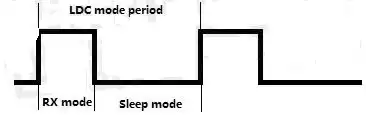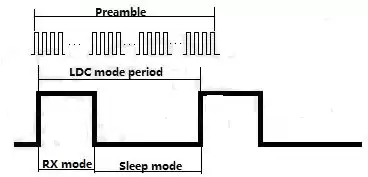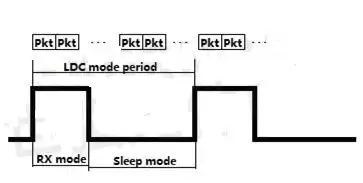Si4463 wireless wake-up principle
Aug . 2021
Silicon Labs' EZRadioPro series of RF chips(Si4438, Si446x, Si4463) are widely used in the Internet of Things, smart home and electricity meter markets with their low power consumption and high performance. In particular, the smart home industry has almost strict requirements for low power consumption. Therefore, LDC mode (Low Duty CycleMode) is added in some RF chips to achieve lower application power consumption.This article describes the principle of wireless wake-up.
Configure the wireless chip to enter theLDC mode to achieve wake-up in the air. The LDC mode essentially configures the chip to work periodically in the RX receive mode and Sleep mode. By adjustingthe duty cycle of RX and Sleep, the purpose of reducing power consumption is achieved, as shown in Figure 1 for the schematic diagram of LDC mode.

Picture 1 LDC Mode timing
During the duration of the LDC mode, the receiver periodically wakes itself up and operates in the Rx (or TX) state. If no valid preamble is detected, a reception error is detected, or the entirepacket is not received, the receiver returns to the WUT state (that is, readyor sleep) at the end of the LDC mode duration, and remains in this mode until A wake-up cycle begins. If a valid preamble or sync word is detected, the receiver delays the duration of the LDC mode to receive the entire packet. If no data packet is received within the duration of the two LDC modes, the receiver will return to the WUT state for the last LDC mode duration until the next wake-up cycle begins. The sleep time plus wake-up time constitutes a running cycle.

So in practical applications, how can the transmitter be configured so that it can wake up the LDC every time?
Method 1: Long preamble. A longer preamble is used to cover the entire LDC cycle, the advantage of this method is that the preamble can completely cover the RX mode of LDC and ensure the success rate of wake-up. The disadvantage is that if the transmitting end just starts sending the preamble, the LDC end is in RX mode. The LDC device must maintain the RX state until the transmission of the entire packet of data is completed, so it will consume too much power.

Picture 2 Long Preamble Wake up
Method 2: short wake-up packet mode. That is, by sending a large number of short wake-up data packets, it is guaranteed that at least one short wake-up data packet can completely fall into the RX state of the LDC side, thereby ensuring that the wake-up is successful. The advantage of this method is that if the wake-up packet can be short enough, the power consumption will be lower, and the LDC end will not be in the RX state for a long time. The disadvantage is that it limits the length of the wake-up packet.

Picture 3 Short packet Wake up
In general, it is recommended to use the second method. This method can reduce the power consumption as much as possible, but some projects send long data packets as LDC wake-up data packets during design.In this case, use long preamble wake-up power has more advantages.
 +86-755-23080616
+86-755-23080616
 sales@nicerf.com
sales@nicerf.com
Website: https://www.nicerf.com/
Address: 309-315, 3/F, Bldg A, Hongdu business building, Zone 43, Baoan Dist, Shenzhen, China


 English
English







